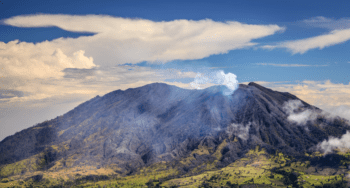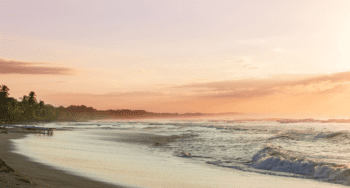Costa Rica Volcanoes: What's Covered
Poás and Irazú volcanoes sit less than 2 hours from San José, offering completely different crater experiences for day-trippers. Poás requires advance reservations through SINAC but features better roads and developed facilities, while Irazú operates first-come-first-served with rougher final approach roads. Having a reliable rental vehicle lets you start early for best crater visibility and explore coffee plantations or Cartago’s basilica along the way.
Quick Facts:
- Poás crater spans 1.5km with turquoise acid lake; Irazú sits at 3,432m elevation
- Entry fees: $15 for foreigners at both parks, ₡1,600 for residents at Poás
- Best viewing: 7-10 AM before clouds roll in, especially February-April
- Standard cars work for Poás; SUVs help with Irazú’s rougher final 10km
- Temperature drops to near freezing at Irazú—pack layers regardless of season
Top 4 Volcano Tips:
- Book Poás 2-3 Days Ahead – Reserve online at serviciosenlinea.sinac.go.cr, arrive by 7 AM for clearest views
- Choose One Per Day – Both in one day is possible but rushed; better to pair with coffee tours or Cartago
- Fill Gas in Alajuela – No stations near either park, mountain driving consumes more fuel
- Pack for Mountain Weather – Bring rain jacket year-round, fleece for elevation changes, good walking shoes
Clear days at Irazú potentially reveal both oceans simultaneously, though this requires perfect atmospheric conditions typically occurring February-April mornings.
If you need any help with a Costa Rica car rental, contact us now!
Costa Rica’s two most accessible active volcanoes sit less than two hours from San José, making them perfect day trip destinations for travelers based in the Central Valley. After years of helping visitors navigate these mountain roads and plan volcano visits, I can tell you that Poás and Irazú offer completely different experiences despite their proximity to each other.
Both volcanoes provide dramatic crater views, but the journey to each reveals different sides of Costa Rica’s landscape and culture. Understanding the differences between these destinations—and the practical considerations for visiting each—can help you choose the right volcano for your interests and schedule.
Key Takeaways
- Poás requires advance online reservations through SINAC (2-3 days ahead), while Irazú operates first-come-first-served.
- Both volcanoes sit under 2 hours from San José, with entry fees at $15 for foreigners at each park.
- Standard rental cars handle Poás’s well-paved roads fine; Irazú’s rougher final 10km benefits from SUV clearance.
- Visit between 7-10 AM for clearest crater views before clouds roll in, especially during dry season (December-April).
- Poás offers developed facilities and wheelchair-accessible trails, while Irazú provides higher elevation views at 3,432 meters.
- Pack layers regardless of season—Irazú temperatures can drop near freezing while Poás stays milder.
- Skip attempting both in one day; instead pair one volcano with nearby coffee tours or Cartago’s historic basilica.
Which Volcano Should You Actually Visit?
The choice between Poás and Irazú often comes down to what type of experience you’re seeking and your tolerance for early morning starts.
What’s Really Different Between Them?
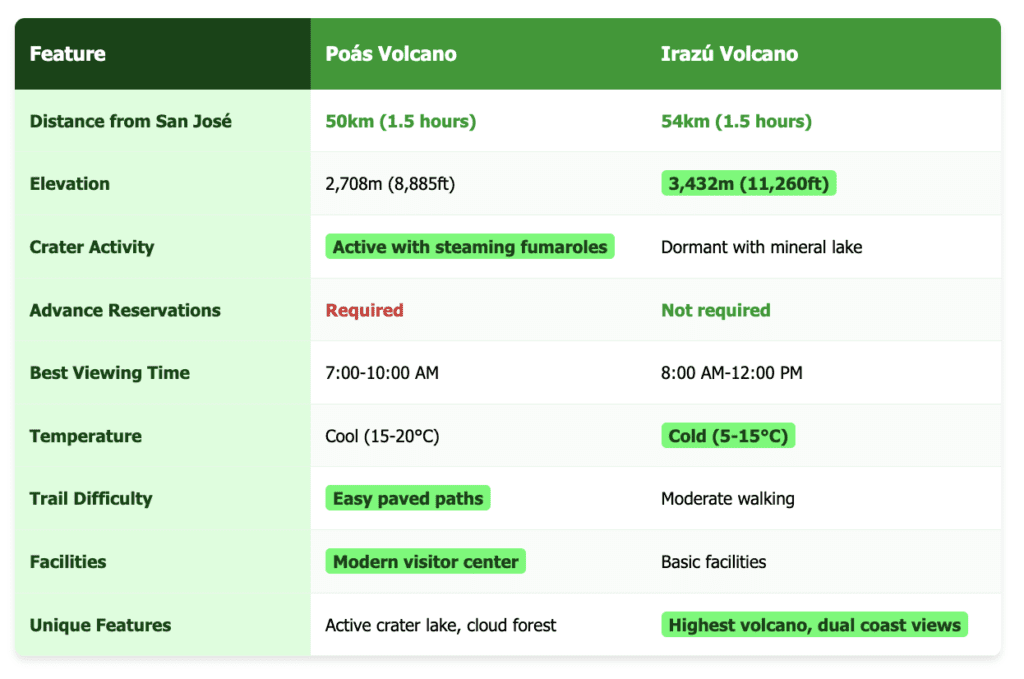
Can You Drive There in a Regular Car?
Both volcanoes are accessible by regular passenger vehicles during the dry season, though road conditions vary significantly. The Poás route features better-maintained pavement throughout, while the final approach to Irazú includes some rougher sections that benefit from higher ground clearance.
During the green season (May-November), morning fog and afternoon rain can make driving more challenging on both routes. A reliable GPS system becomes essential, as mountain weather can change quickly and visibility can drop without warning.
Is Poás Worth the Reservation Hassle?
Poás Volcano National Park protects one of the world’s largest active craters, spanning 1.5 kilometers across and 300 meters deep. The crater contains a sulfuric acid lake that changes colors from emerald green to turquoise depending on volcanic activity and mineral content.
How Do You Actually Get Reservations?
Reservation Requirements: Poás requires advance online reservations through the SINAC website (serviciosenlinea.sinac.go.cr). Reserve at least 2-3 days ahead during the dry season, though spaces sometimes open up for same-day bookings due to cancellations.
Entry Times: The park opens at 7:00 AM with the last entry at 1:00 PM. Early morning visits (7:00-10:00 AM) offer the best crater visibility before clouds roll in.
Park Fees: ₡1,600 for Costa Rican residents, $15 for foreign visitors. Payment accepted in colones or dollars.
What’s the Drive Really Like?
The route from San José takes you north through Heredia, then winds up into coffee plantation territory around Alajuela. The road climbs steadily through small mountain communities where you’ll notice the temperature dropping and vegetation changing from coffee plants to cloud forest.
Key Route Points:
- Take the Carretera General Cañas (Route 1) north from San José
- Exit at San Joaquín de Flores toward Poás
- Follow signs through Vara Blanca village
- Final 10km climbs through dairy farms and cloud forest
Driving Tip: Fill your gas tank in Alajuela or Heredia, as no gas stations operate near the park entrance. The mountain roads require steady acceleration, and running low on fuel isn’t worth the risk.
What Will You Actually See at Poás?
The modern visitor center features geological exhibits, a cafeteria, and clean restrooms—a welcome stop before the short walk to the crater viewpoint. The main crater trail is paved and wheelchair accessible, making this Costa Rica’s most inclusive volcano experience.
Don’t miss: The Botos Trail leads to a secondary crater filled with a peaceful rainwater lake. This 30-minute round-trip hike showcases the cloud forest ecosystem that thrives at this elevation, with chances to spot quetzals and other highland bird species.
The active crater produces sulfur gas emissions that can irritate eyes and respiratory systems. The park monitors gas levels and occasionally closes viewing areas when concentrations become unsafe. Most visitors experience only mild eye watering, but those with respiratory conditions should bring protective masks.
When’s the Best Time for Photos?
Morning light illuminates the crater dramatically between 8:00-9:30 AM. The turquoise crater lake contrasts beautifully with the gray volcanic walls, while steam vents add dynamic elements to photographs.
For wider landscape shots, climb the small hill behind the main viewpoint. This elevated position captures both the active crater and surrounding cloud forest, especially dramatic when morning mist clings to the trees.
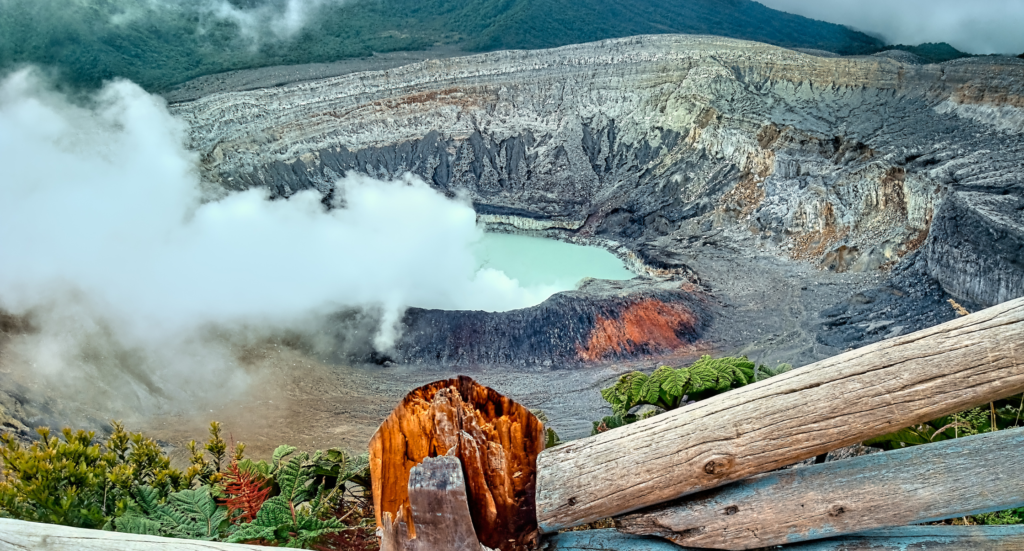
Why Would Anyone Choose Irazú Over Poás?
At 3,432 meters elevation, Irazú represents Costa Rica’s highest volcano and offers the country’s most expansive views on clear days. Unlike the steaming activity at Poás, Irazú’s crater contains a striking green-blue lake surrounded by stark volcanic walls.
Is It Really Easier Without Reservations?
No Reservations Required: Irazú operates on a first-come, first-served basis, making it more flexible for spontaneous visits. However, early arrival remains crucial for clear crater views.
Entry Times: Park opens at 8:00 AM with last entry at 3:30 PM. Unlike Poás, afternoon visits can sometimes offer clear views, though mornings remain most reliable.
Park Fees: ₡1,000 for residents, $15 for foreign visitors.
What’s Different About the Irazú Route?
The route to Irazú passes through Cartago, Costa Rica’s former capital, offering opportunities to visit the famous Basílica de Nuestra Señora de los Ángeles before continuing to the volcano.
Key Route Points:
- Take the Autopista Florencio del Castillo (Route 2) southeast from San José
- Exit into Cartago city center
- Follow signs to “Volcán Irazú” through residential neighborhoods
- Final ascent climbs through vegetable farms and páramo ecosystem
Road Conditions: The final 10 kilometers feature rougher pavement with occasional potholes. Drive slowly and watch for dairy trucks and agricultural vehicles sharing the narrow mountain road.
What Makes Irazú Special?
Irazú offers a more rugged experience compared to Poás’s developed facilities. The visitor center provides basic information and restrooms, but the cafeteria operates irregularly.
The main crater measures 1,050 meters across and 300 meters deep. Its mineral-rich lake shifts colors between emerald green and rust red depending on rainfall and volcanic mineral content. The stark landscape feels almost lunar, with little vegetation surviving at this elevation.
Temperature Warning: Bring layers! Temperatures at Irazú can drop to near freezing, especially during early morning hours or windy conditions. The high elevation and open exposure create a wind chill that catches many visitors unprepared.
Can You Really See Both Oceans?
On exceptionally clear days (typically between February-April), Irazú’s summit offers views of both the Pacific Ocean and Caribbean Sea simultaneously. This phenomenon requires perfect weather conditions—clear skies, low humidity, and no atmospheric haze.
Realistically, you’ll see one coast clearly with hints of the other in the distance. The Pacific side appears more consistently due to prevailing wind patterns, while Caribbean views require specific atmospheric conditions.
Viewing Strategy: Plan your visit for dry season mornings when atmospheric conditions favor long-distance visibility. Even without dual-coast views, the panorama across the Central Valley and surrounding mountain ranges provides spectacular photography opportunities.
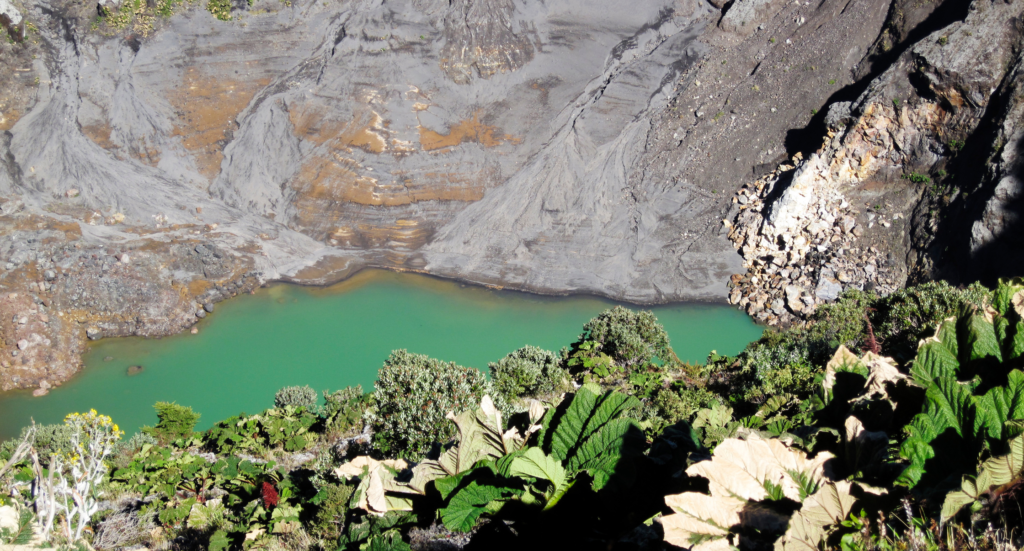
Should You Try to Visit Both in One Day?
Ambitious travelers sometimes attempt both volcanoes in a single day, though this requires careful planning and an early start. The logistics work best by visiting Poás first (requiring those advance reservations), then continuing to Irazú.
What Would That Schedule Look Like?
- 6:00 AM: Depart San José for Poás (arrive by 7:00 AM opening)
- 7:00-9:30 AM: Explore Poás crater and trails
- 10:00 AM: Drive toward Irazú via Cartago (1.5-hour drive)
- 11:30 AM-1:30 PM: Explore Irazú crater and viewpoints
- 2:00 PM: Begin return to San José
Reality Check: This schedule leaves little time for spontaneous exploration or extended photography. You’ll cover both volcanoes but miss opportunities for deeper exploration or relaxed coffee breaks in mountain villages.
Better Alternative: Choose one volcano per day and pair it with complementary experiences. Visit Poás with coffee plantation tours in the surrounding highlands, or combine Irazú with exploration of historic Cartago and its famous basilica.
What Kind of Vehicle Do You Really Need?
Both volcano routes are manageable with standard rental vehicles during dry season, though each presents specific challenges worth understanding before departure.
Can a Compact Car Handle Poás?
The Poás approach features well-maintained pavement through most of the journey, with steeper grades requiring steady acceleration rather than technical driving skills. Mountain curves include guardrails and adequate shoulders for most sections.
Vehicle Needs: Any reliable rental car handles this route comfortably. Compact cars work fine during the dry season, though larger vehicles provide more comfort during the hour-plus driving time.
Why Might You Want an SUV for Irazú?
Irazú’s approach includes rougher pavement sections and steeper grades, particularly during the final ascent through agricultural areas. The road narrows significantly above Cartago, with limited passing opportunities.
Vehicle Needs: While 4WD isn’t required, higher ground clearance helps navigate occasional potholes and road irregularities. Consider an SUV or compact pickup for better road clearance and stability.
What Should You Bring for Mountain Driving?
GPS Navigation: Both routes include mountain roads where cell service becomes spotty. Download offline maps or rent a GPS device to avoid getting lost in rural mountain areas.
Emergency Kit: Bring a basic emergency kit including water, snacks, first aid supplies, and a flashlight. Mountain weather can change quickly, and help may be distant if mechanical problems occur.
Fuel Management: Fill your tank before leaving San José or suburban areas. Gas stations become scarce above 2,000 meters elevation, and mountain driving consumes more fuel than flat highway travel.
When’s Actually the Best Time to Go?
Volcano visibility depends heavily on weather patterns that vary significantly between dry and green seasons.
Is The Dry Season Really That Much Better?
Clear morning skies (December-April) provide the most reliable crater viewing, with minimal cloud cover obscuring mountain peaks. Road conditions remain optimal throughout this period, with no concerns about rain affecting visibility or road traction.
Peak Months: February and March offer the clearest atmospheric conditions, though these months also bring the highest visitor numbers requiring advance planning.
Should You Skip The Green Season Completely?
Don’t dismiss volcano visits during the green season (May-November). Morning hours often feature clear skies before afternoon cloud buildup, and the surrounding landscapes display vibrant green colors impossible during dry season.
Strategy: Start earlier during green season (6:00 AM departures) to reach craters before clouds form. Afternoon rains typically begin around 1:00-2:00 PM at volcano elevations.
What Should You Pack for Mountain Weather?
Mountain weather changes rapidly regardless of season. Pack layers including:
- Light fleece or sweater for elevation changes
- Rain jacket (essential year-round)
- Comfortable walking shoes with good traction
- Hat and sunscreen (UV exposure increases with elevation)
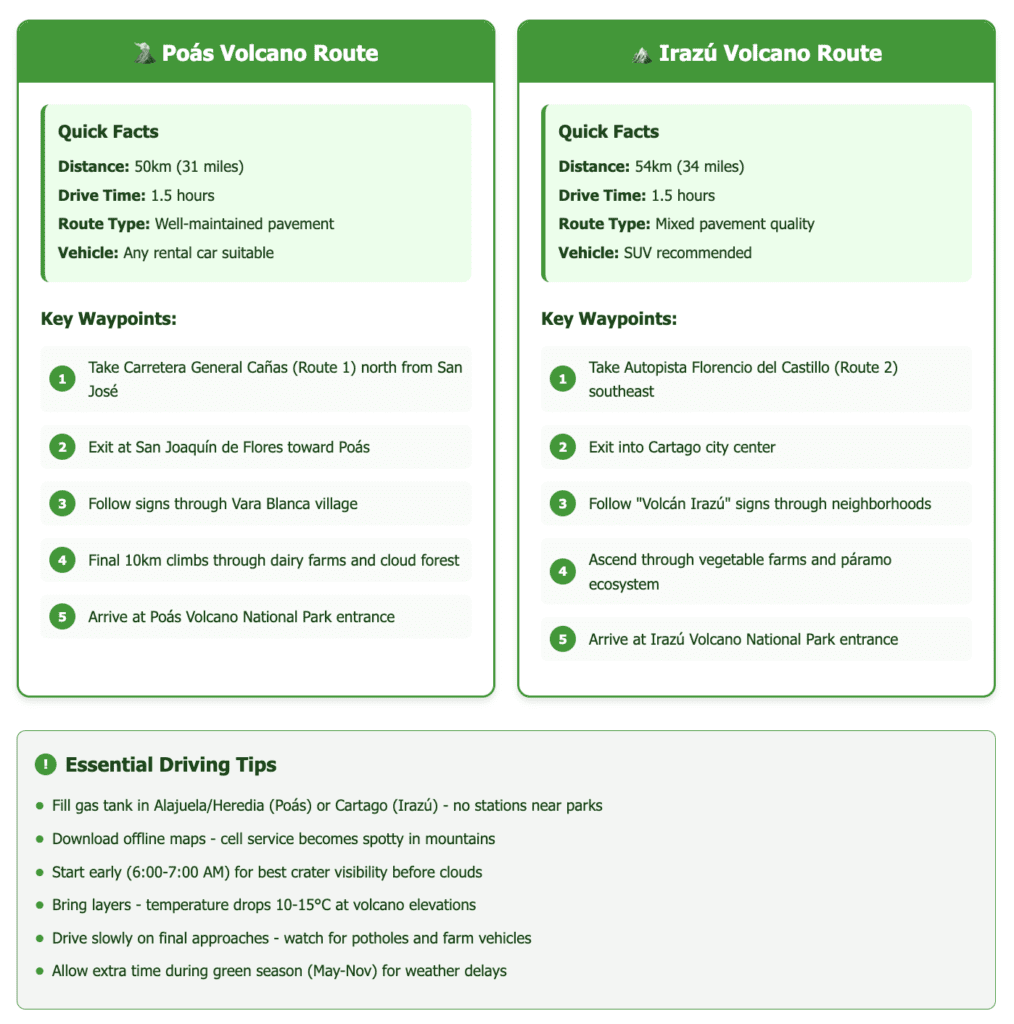
How Do You Get Good Volcano Photos?
Both volcanoes offer dramatic photography opportunities, though each requires different approaches and equipment considerations.
What Camera Gear Actually Helps?
Wide-Angle Lens: Essential for capturing crater scope and surrounding landscapes. The massive crater dimensions can’t be captured effectively with standard focal lengths.
Polarizing Filter: Reduces glare from crater lakes and enhances color saturation in volcanic rock formations. Particularly effective at Irazú where mineral colors can appear washed out in bright sunlight.
Tripod: Morning light conditions and potential wind at elevation benefit from stable camera support, especially for landscape compositions.
When Should You Actually Shoot?
Poás: Golden hour lighting between 8:00-9:00 AM illuminates crater walls dramatically. Steam vents become more visible in cooler morning air.
Irazú: Side lighting between 9:00-11:00 AM enhances crater depth and texture. Late morning sun angle reveals crater wall details often lost in flat midday lighting.

What Else Can You Do Along the Way?
Where Should You Stop for Coffee?
The Poás route passes through prime coffee-growing territory around Vara Blanca and San Pedro de Poás. Several family-run plantations offer informal tours and tastings, providing insight into high-altitude coffee cultivation.
Local Tip: Stop at Restaurante Colbert in Vara Blanca for traditional Costa Rican breakfast with crater views on clear days. This family-run restaurant has served volcano visitors for over 30 years.
Is Cartago Worth a Stop?
The Irazú route provides opportunities to explore Cartago’s historical significance as Costa Rica’s first capital. The Basílica de Nuestra Señora de los Ángeles attracts pilgrims year-round, while nearby ruins of the original cathedral showcase colonial architecture.
Cultural Insight: Visit Cartago’s central market for traditional vegetables grown in volcanic soil around Irazú. Local farmers sell unique root vegetables and highland produce unavailable in San José markets.

Ready to See a Volcano? Here’s Your Action Plan
Choose your volcano based on your priorities and schedule flexibility. Poás offers more developed facilities and easier logistics but requires advance planning. Irazú provides more dramatic elevation and potentially broader views but demands warmer clothing and tolerance for basic facilities.
For First-Time Visitors: Start with Poás for its developed infrastructure and reliable morning viewing conditions. The advance reservation requirement forces proper planning while ensuring entry.
For Adventure Seekers: Choose Irazú for its raw volcanic landscape and elevation challenge. The drive itself becomes part of the adventure, with opportunities to interact with highland farming communities.
For Photographers: Both volcanoes offer unique opportunities. Poás provides active volcanic features and steaming crater action, while Irazú delivers stark lunar landscapes and potential long-distance vistas.
Transportation Solution: Consider renting a reliable vehicle through Vamos Rentacar for maximum flexibility in timing and route selection. Our GPS-equipped vehicles and local road condition updates help ensure smooth mountain driving, while our 24/7 support provides peace of mind when exploring remote volcanic areas.
Book your volcano day trip vehicle in advance, especially during dry season when demand peaks. With proper planning and reliable transportation, both Poás and Irazú offer unforgettable introductions to Costa Rica’s geological wonders—all within easy reach of your San José base.
Ready to explore? Check current park conditions and make your reservations, then get ready for one of Costa Rica’s most accessible natural adventures.


